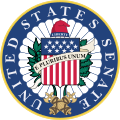This article needs to be updated.(April 2015) |
| This article is part of a series on the |
| United States Senate |
|---|
 |
| History of the United States Senate |
| Members |
| Politics and procedure |
| Places |
The United States Senate Democratic Policy Committee is responsible for the creation of new United States Democratic Party policy proposals, supporting Democratic senators with legislative research, developing reports on legislation and policy, conducting oversight hearings, monitoring roll call votes, differentiating between Democratic and Republican positions, and building party unity.
Contents
- List of chairs
- Vice chairs
- Historical Committee Rosters
- 113th Congress members
- Notes
- References
- External links
The committee was established in 1947, by an act signed by President Harry S. Truman, alongside its Republican counterpart. From 1947 to 2000, the Democratic leader was also the policy committee chairman. From 1989 to 1999, there was a co-chairman. Starting in 1999, the co-chairman was dropped and the position of policy committee chairman became a separate position elected by the Senate Democratic Caucus. The floor leader served as committee chair until 1989, when one of the co-chairs remained leader (Mitchell through 1995 and then Daschle until 1999).